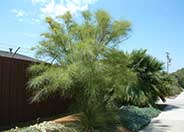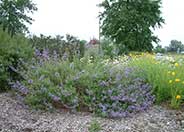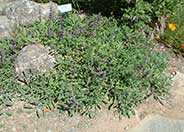
Common name:Mexican Palo Verde, Jerusalem Thorn
Botanical name:Parkinsonia aculeata
The Mexican Palo Verde has prickly stems. This tree is very fast growing with sparse foliage and very long narrow leaves. Yellow flowers with orange red throats bloom sporadically. It is very messy, thorny, weedy and short-lived. This tree is usually found on limestone soils in areas with moisture but is strongly drought tolerant. It can withstand saline conditions. It can be cold or drought deciduous. It is beautiful in form being light and airy looking, with green bark.

Common name:Blue Bush Sage
Botanical name:Salvia 'Allen Chickering'
The Allen Chickering Sage is a perennial shrub that grows 5' high and wide. It has blue flowers that bloom in the spring and summer. This shrub is native to California and is drought tolerant.
Maintenance Tips
Salvia ‘Allen Chickering’ is a hybrid of the California native Cleveland Sage. It is a woody sage that can grow into a dome shape 5' tall and wide. The tall flower stalks emerge in the spring and are very attractive to hummingbirds, bees, and butterflies. It performs best in a sunny location with the space to reach its full mature size. Once the flowers have faded, the spent stalks can be deadheaded to keep the shrub looking tidy and encourage additional flowers. Woody shrubs tend to become dense with lots of cross-branching, so thinning out the branching and allowing sunlight to the interior will benefit the plant and will encourage new, green growth. This shrub can take more aggressive hedging; cutting back by about a third in the winter to keep the nice dome shape.
Common name:Sonoma Sage, Creeping Sage
Botanical name:Salvia sonomensis
This low growing, native ground cover has glaucous (covered with whitish, waxy material) green leaves with blue violet flowers that bloom in the spring and summer.
Photographer: GardenSoft
Practice grass-cycling by leaving short grass clippings on lawns after mowing, so that nutrients and organic matter are returned to the soil.
Remove irrigation water and fertilizer from areas where you don't want weeds to grow.